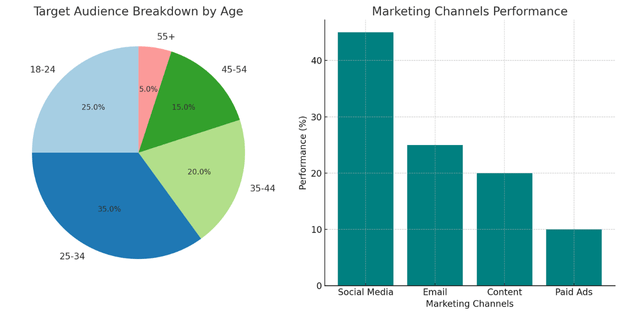What is a Marketing Strategy?
A marketing strategy is a comprehensive plan that helps businesses achieve their goals by identifying and reaching the right audience with the right message at the right time. It’s like a roadmap that guides every marketing effort, ensuring your time, energy, and resources are used effectively.
Here’s a breakdown of the key elements of a marketing strategy:
1. Understand Your Target Audience
Who are your ideal customers? A strong marketing strategy starts with knowing:
- Their age, location, and lifestyle.
- Their challenges and goals.
- What motivates them to buy.
This helps you create messages that truly resonate.
2. Define Clear Goals
What do you want to achieve? Examples of marketing goals include:
- Growing your social media following.
- Increasing website traffic.
- Boosting sales of a specific product or service.
Your strategy should focus on actions that lead directly to these outcomes.
3. Develop Your Unique Value Proposition (UVP)
Why should customers choose you over your competitors? Your UVP highlights:
- What makes your business special.
- How your products or services solve problems.
- The unique benefits you provide.
A clear UVP helps your brand stand out.
4. Choose the Right Marketing Channels
Where does your audience spend their time? Your strategy should prioritize channels like:
- Social media platforms (Facebook, Instagram, TikTok).
- Email marketing campaigns.
- Content marketing (blogs, videos, podcasts).
- Paid advertising (Google Ads, social media ads).
5. Create Engaging Content
Content is the backbone of any marketing strategy. Focus on creating:
- Informative blog posts or articles.
- Eye-catching graphics and videos.
- Compelling offers like discounts or free resources.
The goal here is to keep your audience interested and engaged.
6. Set a Budget
Marketing efforts cost time and money. Decide how much you can invest in:
- Ads and promotions.
- Hiring experts or tools.
- Creating professional content.
A realistic budget helps you stay on track.
7. Monitor and Measure Results
How do you know if your strategy is working? Use tools like Google Analytics or social media insights to track:
- Website traffic.
- Click-through rates on ads.
- Sales or sign-ups.
By reviewing your data, you can make adjustments to improve results.
8. Stay Flexible and Adapt
Markets change, and so do customer needs. A good marketing strategy is flexible, allowing you to adjust as trends, technologies, or customer behaviors evolve.
Why is a Marketing Strategy Important?
- It saves time and money by focusing on what works.
- It helps you compete effectively in your market.
- It builds a strong, consistent brand that customers trust.

We’ve created two visualizations to complement the explanation of our marketing strategy:
- Target Audience Breakdown by Age (Pie Chart): This chart highlights the percentage distribution of age groups in your target audience, giving you a sense of who your primary customers might be.
- Marketing Channels Performance (Bar Chart): This graph shows the relative effectiveness of various marketing channels, helping you prioritize where to focus your efforts.

Leave a Reply